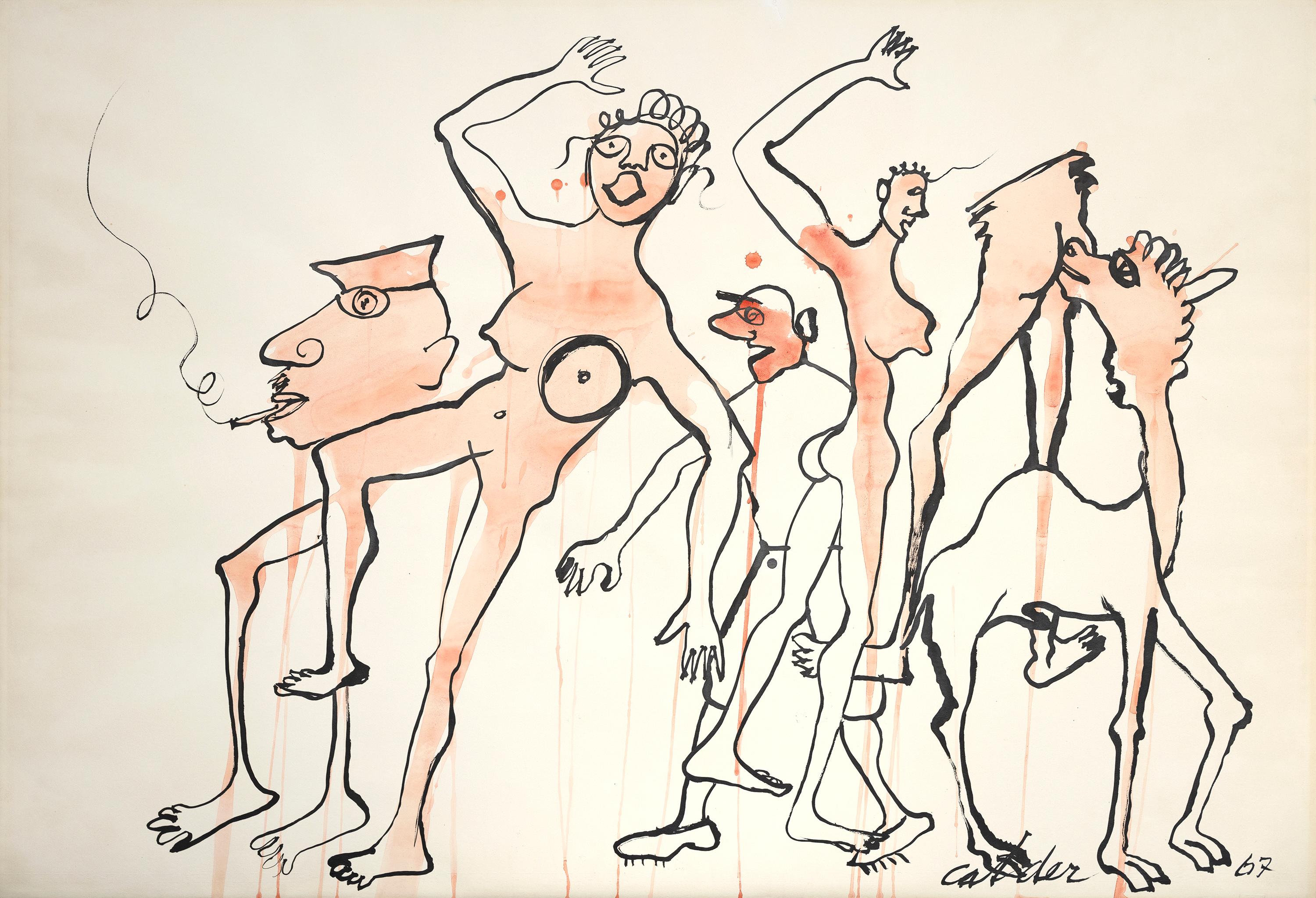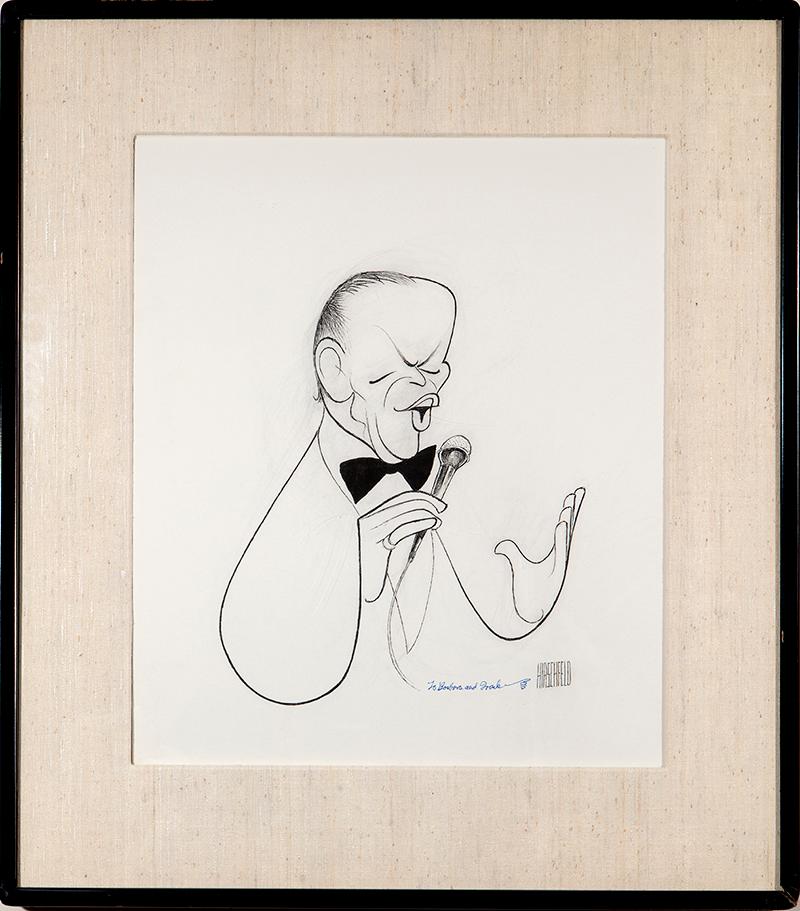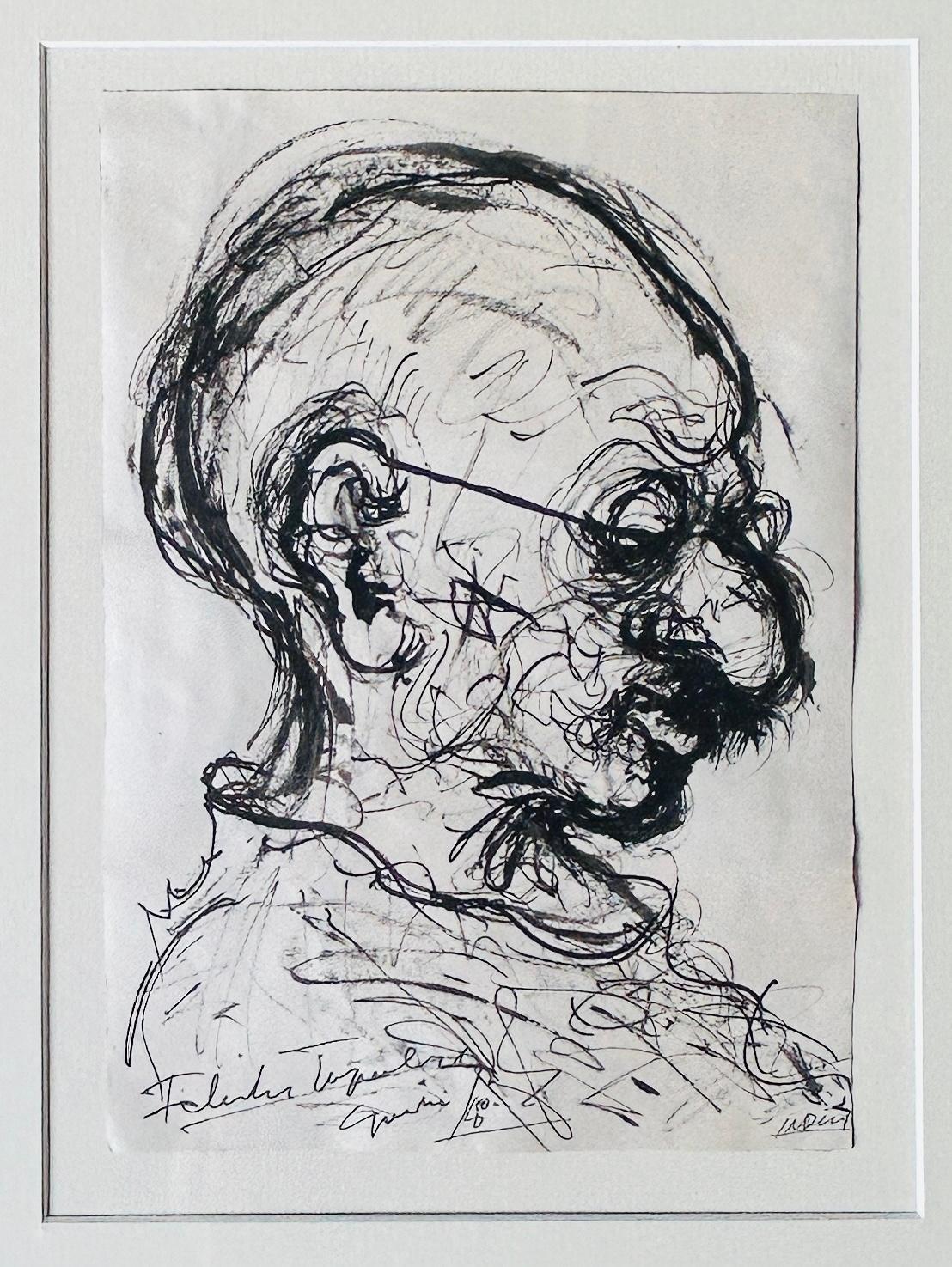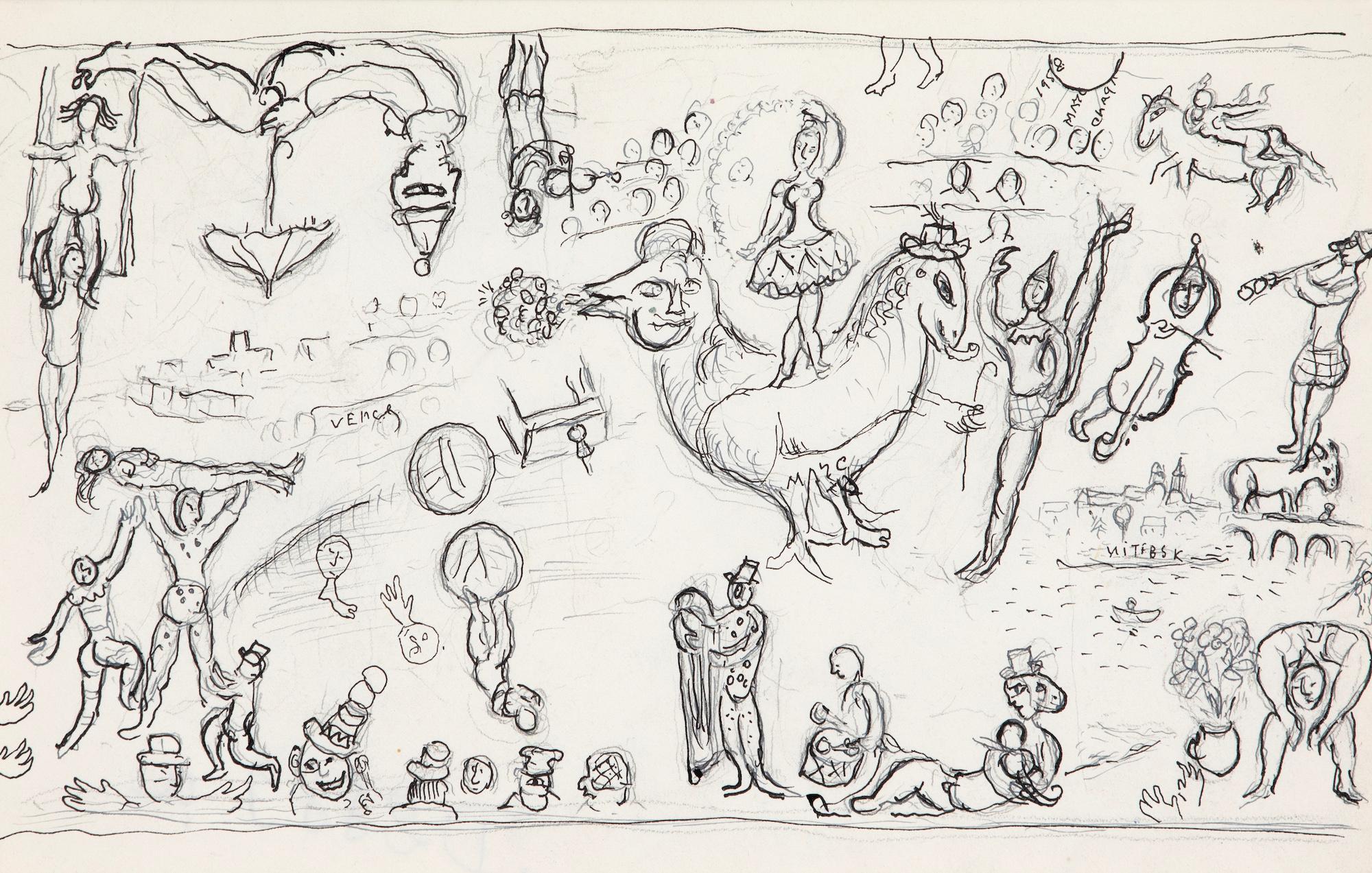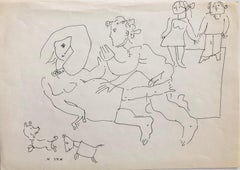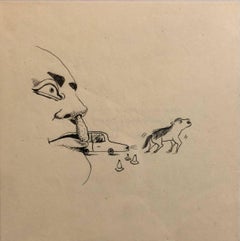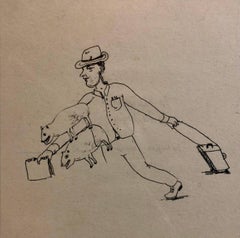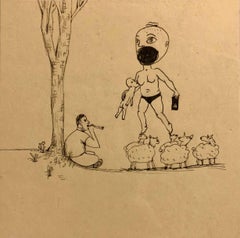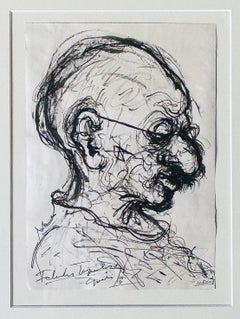Items Similar to Rare Judaica Drawing Sephardic Rabbi Gentleman, Palestine
Want more images or videos?
Request additional images or videos from the seller
1 of 7
Arieh MerzerRare Judaica Drawing Sephardic Rabbi Gentleman, Palestine
About the Item
Dimensions w/Frame: 17 1/2" x 11 1/2"
Arieh Merzer was a prominent Israeli artist and metal worker.
Arie Merzer, an artist who worked in hand-hammered copper, was born in Warsaw, Poland in 1905, the scion of a large Hassidic family. He graduated from the Academy of Arts in Warsaw, and became the pupil of Professor Adam Richtarsky. He later worked with a group of Jewish artists who wanted to resuscitate the ancient oriental-Jewish craft of hand-hammering metal (metaloplastics), which was passed on to us as a legacy by far-off generations from the time of the Bible.
In 1928 Arieh Merzer exhibited his works in Warsaw for the first time. From 1930 he lived and worked in Paris. He was one of the Jewish artists who gathered there and were known as the Jewish 'Ecole de Paris.' Merzer regularly exhibited in the well-known 'Salon d'Automne' and 'Salon des Tuileries,' as well as in solo exhibitions in Paris and throughout France.
Arieh Merzer's work was highly acclaimed well before the Holocaust, before it became a memorial to a world destroyed. He portrayed the story of the Jewish spirit on copper, on silver, and on gold: stories from the Bible, the life-styles of the Jews in their shtetls and ghettos, of Chassidim and Kabbalists of renown, of wars of liberation and revival.
A special stress was placed on the link between the new Jewish experience and its historical nucleus. His major innovation was the moulding of mystic and traditional Jewish motifs, that surrounded the Holy Ark in Europe's burning synagogues, and presenting the results before the world of modern art. As a result he became generally recognized as an international Jewish artist.
In 1943, when France was conquered by the Nazis, Arieh Merzer escaped from a concentration camp, and after a stint in the maquis, he crossed the border into Switzerland and was sent to a labor camp. Later, he arrived in Geneva, where an album of sketches of his works was put out. In 1945 he made aliyah to Israel with his family, settled in Safed, and helped to found the Artists' Quarter there.
Arieh Merzer lived and worked in Israel for twenty-one years. His exhibitions in the country include: 1946 in the Tel Aviv Museum; 1947 in the Pevsner Artists' Pavilion in Haifa; 1951 in the Artists' Pavilion in Tel Aviv; 1955 in the Museum for Modern Art in Haifa; 1955 in the Artists' Pavilion in Jerusalem; and 1957 in the Tel Aviv Museum. His works were also on permanent show in his atelier in Safed. He was awarded prizes, including: the Herman Struck prize in 1946; the Dizengoff prize in 1951 and then again in 1965; and the Mayor of Haifa's prize in 1954. His works appear in numerous museums and collections throughout the country and abroad. His heart stopped beating on the eve of Holocaust Day, 1966.
Arieh Merzer, who was brought up in a Hassidic family, was drawn to the world of art from an early age; he was influenced by the moods and new ideals of the socialist circles and prepared himself to study art in the academy. On Passover eve , after clearing out the bread, while the rest of the household was busy preparing for the Holiday, a book fell from the bookcase and from out its pages flew dozens of sketches and drawings of nudes that the young Arieh had prepared for his folio for the entrance examinations to the academy. His sisters tore up the drawings with cries of treyfe treyfe (ritually non-kosher) and many months' hard work went down the drain. As a result of this, he left his home at the age of fifteen, and later joined a group of young artists who wanted to revive the ancient art of hand-hammered copper - metaloplastics - bequeathed to them by past generations who lived in Bible times.
Thus did he part from his family - mother, father, thirteen brothers and sisters - who all perished in the Holocaust. He alone survived, and made an oath that he would commemorate in copper all who had died.
The pictures do not do justice to this magnificent item.
- Creator:Arieh Merzer (1905 - 1966, French)
- Dimensions:Height: 17.5 in (44.45 cm)Width: 11.5 in (29.21 cm)
- Medium:
- Period:
- Condition:
- Gallery Location:Surfside, FL
- Reference Number:1stDibs: LU38211501102
About the Seller
4.9
Platinum Seller
These expertly vetted sellers are 1stDibs' most experienced sellers and are rated highest by our customers.
Established in 1995
1stDibs seller since 2014
1,591 sales on 1stDibs
Typical response time: 1 hour
- ShippingRetrieving quote...Ships From: Surfside, FL
- Return PolicyA return for this item may be initiated within 3 days of delivery.
Authenticity Guarantee
In the unlikely event there’s an issue with an item’s authenticity, contact us within 1 year for a full refund. DetailsMoney-Back Guarantee
If your item is not as described, is damaged in transit, or does not arrive, contact us within 7 days for a full refund. Details24-Hour Cancellation
You have a 24-hour grace period in which to reconsider your purchase, with no questions asked.Vetted Professional Sellers
Our world-class sellers must adhere to strict standards for service and quality, maintaining the integrity of our listings.Price-Match Guarantee
If you find that a seller listed the same item for a lower price elsewhere, we’ll match it.Trusted Global Delivery
Our best-in-class carrier network provides specialized shipping options worldwide, including custom delivery.More From This Seller
View AllVintage Israeli Bezalel School Drawing Family Playing, Dogs Puppies Kibbutz Life
By Moshe Avni
Located in Surfside, FL
Moshe Avni was born in 1937, in Kibbutz Kfar Blum in the Upper Galilee in Israel. Presently, he lives and paints in Jerusalem. During the years 1956-1957, he studied Painting and Gra...
Category
1960s Modern Figurative Drawings and Watercolors
Materials
Paper, Ink, Pen
Collaborative Contemporary Surrealist Cartoon Drawing Humphrey + Coates
By David Humphrey
Located in Surfside, FL
signed by both in pencil verso. dated.
Surrealist cartoon drawing. Actual drawing size is 5.75 X 5.75.
Their collaborative works on paper emerge out of an ongoing relationship where...
Category
Early 2000s Pop Art Animal Drawings and Watercolors
Materials
Paper, Ink
Collaborative Contemporary Surrealist Cartoon Drawing Humphrey + Coates
By Jennifer Coates
Located in Surfside, FL
signed by both in pencil verso. dated.
Surrealist cartoon drawing. Actual drawing size is 5.75 X 5.75.
Their collaborative works on paper emerge out of an ongoing relationship where...
Category
Early 2000s Pop Art Animal Drawings and Watercolors
Materials
Paper, Ink
Collaborative Contemporary Surrealist Cartoon Drawing Humphrey + Coates
By Jennifer Coates
Located in Surfside, FL
signed by both in pencil verso. dated.
Surrealist cartoon drawing. Actual drawing size is 5.75 X 5.75.
Their collaborative works on paper emerge out of an ongoing relationship where...
Category
Early 2000s Pop Art Animal Drawings and Watercolors
Materials
Paper, Ink
Collaborative Contemporary Surrealist Cartoon Drawing Humphrey + Coates
By Jennifer Coates
Located in Surfside, FL
signed by both in pencil verso. dated.
Surrealist cartoon drawing. Actual drawing size is 5.75 X 5.75.
Their collaborative works on paper emerge out of an ongoing relationship where...
Category
Early 2000s Pop Art Animal Drawings and Watercolors
Materials
Paper, Ink
Original German Expressionist Drawing Ernst Ludwig Kirchner Women Dancing
By Ernst Ludwig Kirchner
Located in Surfside, FL
Ernst Ludwig Kirchner ( Germany 1880-1938 )
Expressionist Female Women Dancing Mixed Media on Paper Drawing or Painting Expressionism
Dimensions: 20" L 16" H in
This bore a sticker from Christies auction house and another collection sticker verso but they have been inadvertently removed. I do have the photo.
Ernst Ludwig Kirchner (1880 – 1938) was a German expressionist painter and printmaker and one of the founders of the artists group Die Brücke or "The Bridge", a key group leading to the foundation of Expressionism in 20th-century art. He volunteered for army service in the First World War, but soon suffered a breakdown and was discharged. His work was branded as "Entartete Kunst" or "degenerate" by the Nazis in 1933, and in 1937 more than 600 of his works were sold or destroyed.
Ernst Ludwig Kirchner was born in Aschaffenburg, Bavaria. His parents were of Prussian descent and his mother was a descendant of the Huguenots, a fact to which Kirchner often referred. As Kirchner's father searched for a job, the family moved frequently and Kirchner attended schools in Frankfurt and Perlen until his father earned the position of Professor of Paper Sciences at the College of technology in Chemnitz, where Kirchner attended secondary school. Although Kirchner's parents encouraged his artistic career they also wanted him to complete his formal education so in 1901, he began studying architecture at the Königliche Technische Hochschule (royal technical university) of Dresden. The institution provided a wide range of studies in addition to architecture, such as freehand drawing, perspective drawing and the historical study of art. While in attendance, he became close friends with Fritz Bleyl, whom Kirchner met during the first term. They discussed art together and also studied nature, having a radical outlook in common. Kirchner continued studies in Munich from 1903 to 1904, returning to Dresden in 1905 to complete his degree.
In 1905, Kirchner, along with Bleyl and two other architecture students, Karl Schmidt-Rottluff and Erich Heckel, founded the artists group Die Brücke ("The Bridge") later to include Emil Nolde, Max Pechstein and Otto Mueller. From then on, he committed himself to art. The group aimed to eschew the prevalent traditional academic style and find a new mode of artistic expression, which would form a bridge (hence the name) between the past and the present. They responded both to past artists such as Albrecht Dürer, Matthias Grünewald and Lucas Cranach the Elder, as well as contemporary international avant-garde movements. As part of the affirmation of their national heritage, they revived older media, particularly woodcut or woodblock prints.
Kirchner's studio became a venue which overthrew social conventions to allow casual love-making and frequent nudity. Group life-drawing sessions took place using nude models from the social circle, rather than professionals, and choosing quarter-hour poses to encourage spontaneity. In 1911, he moved to Berlin, where he founded a private art school, MIUM-Institut, in collaboration with Max Pechstein with the aim of promulgating "Moderner Unterricht im Malen" (modern teaching of painting). This was not a success and closed the following year, when he also began a relationship with Erna Schilling that lasted the rest of his life. In 1917, at the suggestion of Eberhard Grisebach [de], Helene Spengler invited Kirchner to Davos where he viewed an exhibition of Ferdinand Hodler paintings. "When I was leaving, I thought of Vincent Van Gogh's fate and thought that it would be his as well, sooner or later. Only later will people understand and see how much he has contributed to painting".
In 1921 Kirchner visited Zurich at the beginning of May and met the dancer, Nina Hard, whom he invited back to Frauenkirch (despite Erna's objections). Nina Hard would become an important model for Kirchner and would be featured in many of his works. Kirchner began creating designs for carpets which were then woven by Lise Gujer.
In 1925, Kirchner became close friends with fellow artist, Albert Müller...
Category
Early 20th Century Expressionist Figurative Drawings and Watercolors
Materials
Ink, Paper
You May Also Like
Personnages
By Alexander Calder
Located in Palm Desert, CA
"Personnages" is a gouache on paper by Alexander Calder. The work is signed in the lower right, "Calder 67".
Although renowned for his innovative and groundbreaking sculptures, Alex...
Category
1960s Figurative Drawings and Watercolors
Materials
Ink, Paper, Gouache
"Frank Sinatra"
By Albert Al Hirschfeld
Located in Lambertville, NJ
Jim's of Lambertville Fine Art Gallery is proud to present this piece by Albert Hirschfeld (1903 – 2003).
At the age of 12, Albert Hirschfeld, the famed caricaturist who depicted figures in the New York theater...
Category
1960s Other Art Style Figurative Drawings and Watercolors
Materials
Paper, Ink
Gareth Pugh. Watercolor drawing on paper
By Manuel Santelices
Located in Miami Beach, FL
Gareth Pugh, by Manuel Santelices
Ink pen, and watercolor on paper
Image size: 9 in. H x 12 in. W
Unframed
2021
The artist have covered the New York Collections for over 16 years a...
Category
21st Century and Contemporary Contemporary Figurative Drawings and Water...
Materials
Ink, Paper, Watercolor, Pen
India Modern Art Drawing Felix Topolski Gandhi India Signed and Dated 1950
Located in Norfolk, GB
Felix Topolski (1907-1989)
Gandhi
Pen and ink on paper
Image 10.5” x 7.5”, Framed 26” x 21.5”
Signed and Dated 1950, India
Provenance: Private UK Collection
Felix Topolski (1907-1...
Category
1950s Abstract Impressionist Figurative Drawings and Watercolors
Materials
Paper, Ink, Pen
"Hanging Scroll of Prunus Branches, " Ink on Paper
Located in Chicago, IL
Chinese scholars used natural imagery and scenery to aid in contemplation within the walls of their studios. The complex beauty inherent to landscapes and natural forms inspired clea...
Category
19th Century Qing Figurative Drawings and Watercolors
Materials
Paper, Ink
Esquisse pour "Commedia dell'arte" by Marc Chagall - Drawing
By Marc Chagall
Located in London, GB
*THIS PRICE INCLUDES 5% IMPORT DUTY APPLICABLE IF THE WORK REMAINS IN THE UK ONLY.
Esquisse pour "Commedia dell'arte" by Marc Chagall (1887-1985)
India ink, pen and pencil on paper...
Category
1950s Modern Figurative Drawings and Watercolors
Materials
Paper, India Ink, Pen, Pencil
